Wedged between Byculla and Bombay Central, tough-talking Agripada has also always touched lives with a tender tradition of social service
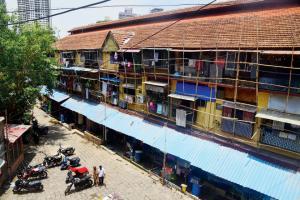
.
 She had the temerity to tell MF Husain, "What's this nonsense, I can paint better than you." The artist laughed indulgently at Tasneem Tinwala, little more than a toddler when they lived across a landing of Goorishina building in 1970s Agripada. The two families' front doors open daylong, children skipped in and out of each other's homes. "He would mix colours on the living room floor — with his hands, no brush — warning, 'Step carefully, don't slip!'"
She had the temerity to tell MF Husain, "What's this nonsense, I can paint better than you." The artist laughed indulgently at Tasneem Tinwala, little more than a toddler when they lived across a landing of Goorishina building in 1970s Agripada. The two families' front doors open daylong, children skipped in and out of each other's homes. "He would mix colours on the living room floor — with his hands, no brush — warning, 'Step carefully, don't slip!'"
ADVERTISEMENT
Husain's son Owais says, "We moved to Goorishina for its proximity to Patrao Maternity Nursing Home, convenient when my mother was expecting me. The house was always busy with artists, writers and poets, noisy in their guffaws and heated conversations. Unbelievable how we comfortably accommodated the traffic of visitors in our small apartment crowded with a relatively large family and a flow of my father's barely dry paintings on the walls."
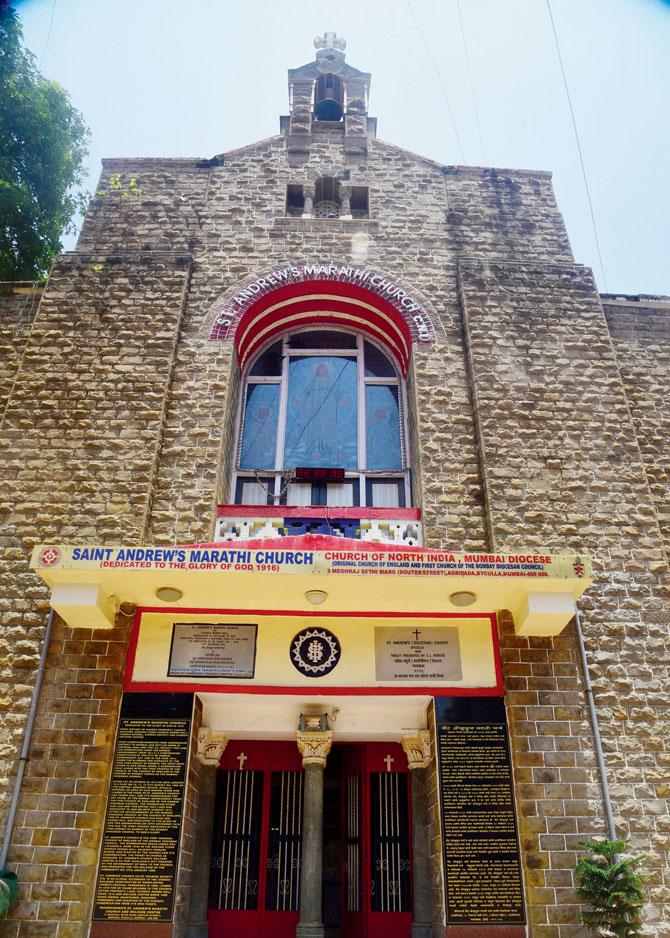
Handsomely restored in Porbunder stone and stained glass, 103-year-old St Andrew's Marathi Church still serves around 65 Agripada families
That was on Souter Street, named after Bombay's first and longest serving Police Commissioner, Sir Frank Souter (1864-88). His Madanpura residence, today the Mukti Fauj Dawakhana, Salvation Army Dispensary, acknowledges Unani physician Hakim Ajmal Khan, a Khilafat Movement stalwart and co-founder of Jamia Millia Islamia University.
Flanked tight by west Byculla and east Bombay Central, this "hamlet (pada) of the Agris" was where three types of cultivators (Agris) settled: Bhat Agris or rice planters, Mitha Agris or salt manufacturers and Bhaji-pala Agris or vegetable farmers. The Bombay City Gazetteer, I. 144, mentions seven Agri clans among first immigrants in 1294. Koli fishermen drifted coastwards. The Agris' fields gradually became industrial estates and chawls housing textile mill mazdoors.
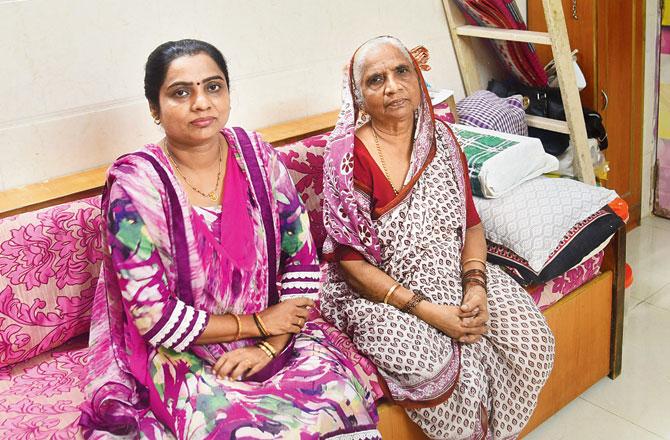
Anasuya Dhone and her daughter Shubhangi Jadhav at the BIT (Bombay Improvement Trust) Chawl they live in. Like other housing tenements of its kind, the almost 110-year-old chawl is likely to go in for redevelopment. Pics/Atul Kamble
On Madhavrao Gangan Marg, I reach the 107-year-old BIT (Bombay Improvement Trust) Chawl where Anasuya Dhone has spent 50 years in her Building No. 3 room. "My husband's boss was Parsi like you, a storekeeper for Limji Seth of the Bombay Cycle and Motor Agency," she smiles. Offering me delicious rose doodh, her daughter Shubhangi Jadhav says, "The 1992-93 riots shattered our peace. But when curfew shut shops, kind Memons supplied us basic provisions, bread and milk."
Owais Husain writes from Dubai, "In Agripada the phrase 'It takes a village to bring up a child' held true. Neighbours were the village, there was strong community feeling. The locality was lush in trees filled with noisy birds and plenty of fruits. Baby Garden was the nerve centre for kids, with ragda chaat and roast corn sellers, horse rides, places to run and hide... With the exaggerated sense of scale in younger years, I thought the park was a dense forest of unpruned foliage. We sailed the monsoon-flooded street in an inflatable raft a girl from our building had."
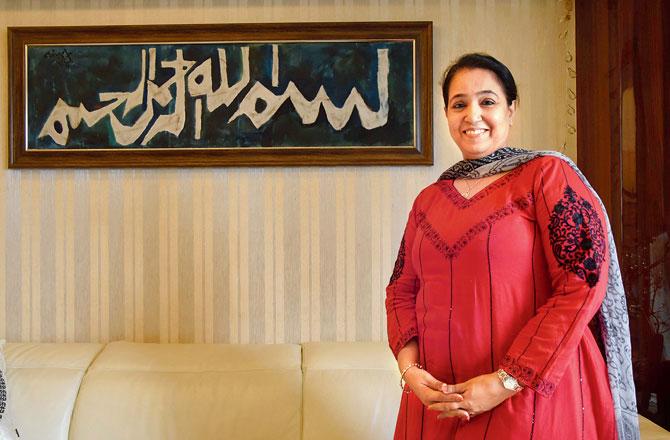
Tasneem Tinwala-Kachwala stands beside MF Husain’s rendition of the invocation, "Bismillah-ir-Rahman-ir-Rahim" (In the name of God, most Gracious, most Compassionate). Observing Tasneem's mother fast through the sacred month of Rajab, Husain gifted her this painting when they were neighbours on Souter Street. He took the work back briefly to change the position of his signature, replacing it more appropriately below the mention of God. Pic/Suresh Karkera
Saturated, imploding, Maximum City's inexorable pressures and pulls have reshaped its chawls. In the early 1900s they were well ventilated, with wide stairs, high ceilings and thatched roofs. Till several were forced to transform to gritty ghettos. At the infamous Dagdi Chawl, basements sprouted on the thinnest paths, getaways to secluded warrens in Agripada's alley maze.
Fervently played football tournaments resulted in the Madanpura team usually winning. Competing sports clubs, called kreeda kendras, jointly celebrated Iftaar feasts and Dr Ambedkar's birthday, getting together to stitch banners and buntings for the occasions.
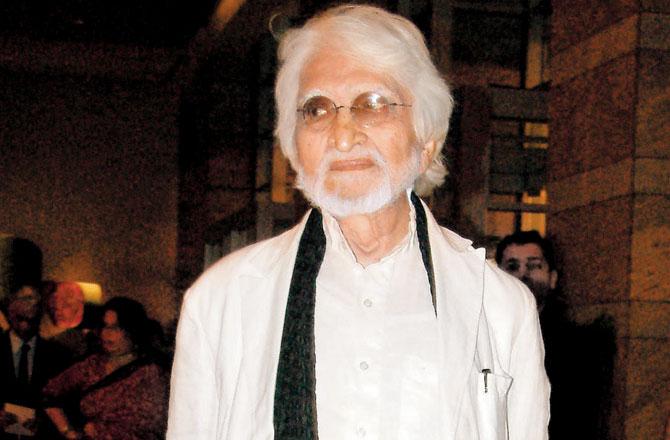
MF Husain, one of Agripada's most famous residents
Around the time the 1982 textile strike spiked unemployment and frustration, a member of the Om Byculla Kabaddi Mandal cast himself as Robin Hood. With rootless youngsters and ruthless gangsters attracted to his brash benevolence, Arun Gawli unilaterally sorted issues, from water wars to school admissions, the chawl courtyard a daily durbar space.
Fatigued fighting notorious enemies, threatened by encounter specialists bringing the underworld to its knees, the clan of the retired but arrested don they call Daddy remains resolutely here. Passersby point to the still hanging signboard of Akhil Bharatiya Sena, the party Gawli launched in 1997.
Outside, in grimy gullies on this soil of slog, a working class mired in debt and despair, dreams. Baint ki Chawl bustles with parents pleading enrolment to Madanpura's first English primary school — "I struggle in a leather karkhana job. At least children should benefit from Angrezi education," says a woman near Al Madina Masjid on Motlibai Street.
Steeped in crime and lawlessness, Agripada shines a softer beam, too, eluding most seeing it solely as a history-sheeter haven. Beyond mafia machinations and cases of brutal violence brought to Agripada Police Station, the rough precinct has traditions of philanthropy and welfare. The Young Men's Christian Association and Young Women's Christian Association, Salvation Army Headquarters, Central Society for the Education of the Deaf, Aruna Children's Shelter and the Blind Working Men's Hostel minister tenderly to generations.
Rowed along the same stretch as Ahmadiyya Masjid, the Light of Life bookshop is in its sixty-second year of publishing Christian journals. It was set up by Jane McNally, the missionary fondly dubbed "McNally Tai" in remote parts of northwest Maharashtra she dedicated herself to.
Six years following its foundation in 1875 the Bombay YMCA's inaugural building, at Apollo Bunder, known as the Hall and Coffee Room, provided European sailors and Anglo Indians snacks, newspapers and writing material to send letters home. The organization's influential British presidents garnered funds for four buildings between 1907 and 1915: Central branch at Wodehouse Road, Students branch at Lamington Road, Procter branch at Agripada's Rebsch Street and Byculla branch at YMCA Road, the last razed to accommodate the International House in 1974.
"The Procter YMCA is simple and functional, reminiscent of brick masonry plastered buildings in Calcutta with deep verandahs and jack arches," says conservation architect Vikas Dilawari, of the building that commemorates YMCA treasurer, Sir Henry Procter. "There's interesting openness around — on its west a playground, on its east badminton courts
converted to the popular swimming pool. Rain trees and wide grounds attached to missionary institutions marked the character of this place, an oasis in a fast changing neighbourhood."
Close to Procter House, on Dr Leela Melville Road, stands the Missionary Settlement for University Women (MSUW) hostel for collegians across India. "Its old-time charm suggests a quality of life that involved planning among architectural tools," says Dilawari, who has also restored this. Engraved in marble at the entrance is the date, 1913, with the Society of Jesus motto "Ad maiorem Dei gloriam – For the greater glory of God".
Further up the street is another lovely Latin phrase to learn. "In hoc Signo vinces", meaning "In this Sign thou shalt conquer", etched on a wall of St Joseph's Home and Nursery. Managed by the Congregation of the Daughters of the Cross, this extends facilities from a daycare creche to Std X for 2,400 girls. It was a foundling home in 1863, the principal, Sister Renita Pinto, informs. Heading the school decades after being its student, she was taught math and science by Nafisa Hakim. "I had the most brilliant girls throughout my 20 years from 1974 to '94," says Hakim, debunking the discrimination that slots boys ahead of girls in her subjects. Going on to teach math and science at a boys' school, she concludes, "As if aptitude varies because of gender. Children are children, with some individual variations."
Back on Souter Street, now Meghraj Sethi Marg, I reach the Porbunder stone St Andrew's Marathi Church, serving about 65 families from humble homes. That its parishioners of 1916 — when Marathi and Gujarati priests addressed mass — must have been labourers, including creative carpenters, is evident from 72 differently carved crosses at the altar.
Sabrina Modak, who conducts heritage walks, called Journeys Imagined, directs me to "the mill workers' library". Communist insignia hammered firm into iron gates, this is the Awami Idara ("public establishment") Urdu Library near Maulana Azad School. Named by Kaifi Azmi, the cultural hub started in 1952, supported by mazdoors of Mominpara, Kalapani and Sankli Street. At its prime, the adda sang the passionate lyrics of Sahir Ludhianvi and Ali Sardar Jafri, and soaked in the stirring speeches of other Progressive Writers' Movement heroes. Tired of toiling at looms, mazdoors welcomed their introduction to Russian cinema and plays staged by Indian People's Theatre Association.
A tailoring institute on the first of the library building's two levels bears traces of an ancestral skill the men who christened Mominpara practised. Grooms-to-be of the Momin community who wove fine mulmul cloth could woo the best brides.
Despite Agripada's cottages-turned-concrete towers, vignettes surge sharp in the minds of those whose growing up acres these were. An old-timer recollects film publicist Bunny Reuben's family among a fair number of Jewish neighbours. His grandfather is supposed to have switched the original surname from Nagavkar to Reubens by the 1920s, to seem suitably Western for the Sassoons as potential employers. Owais Husain says, "A high-rise replaced my building. Yet, when I drove through the neighbourhood a couple of years ago, it echoed loudly for me with memories of a childhood that was vibrant and free."
Decrepitude sullies the most striking structures. In the Urdu Library's visitors' book, filmmaker KA Abbas remarked on May 1, 1975: "The Idara will go higher than the soaring Qutub Minar." If only.
Author-publisher Meher Marfatia writes fortnightly on everything that makes her love Mumbai and adore Bombay. You can reach her at mehermarfatia@gmail.com/
www.mehermarfatia.com
Catch up on all the latest Crime, National, International and Hatke news here. Also download the new mid-day Android and iOS apps to get latest updates
 Subscribe today by clicking the link and stay updated with the latest news!" Click here!
Subscribe today by clicking the link and stay updated with the latest news!" Click here!






